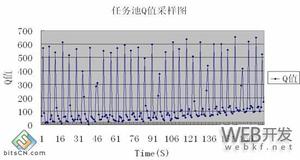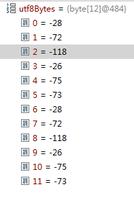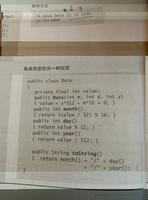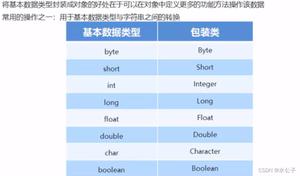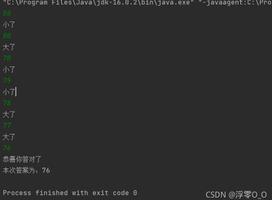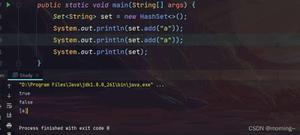java基础-- 集合框架 之 Set集合

一、HashSet与TreeSet比较
Set:元素是无序(存入和取出的顺序不一定一致),元素不可以重复。
Set集合的功能和Collection是一致的。
1、hashSet与TreeSet比较
HashSet
|--HashSet: 底层数据结构是哈希表、是线程不安全的、不同步。
TreeSet
|--TreeSet:可以对Set集合中的元素进行排序,底层数据结构是二叉树(有一定的顺序)。
而且往里存入的对象必须具备比较性,进而进行排序,最后存入
二、hashSet集合
1、HashSet是如何保证元素唯一性的呢?
是通过元素的两个方法,hashCode和equals来完成。
如果元素的HashCode值相同,才会判断equals是否为true,如果元素的hashcode值不同,不会调用equals。
我们一般存储对象的时候,都要复写这两个方法。因为原有的hashCode和equals方法都是根据地址或根据地址算出来的值来进行比较,
(hashCode内部调用的也是equals方法)没意义,所以复写hashCode和equals方法,按照元素自身条件特点来判断元素的唯一性。
注意: 对于判断元素是否存在,以及删除等操作,依赖的方法也是元素的hashcode 和equals方法。
使用HashSet集合存储自定义对象示例代码:
要求:如果姓名和年龄相同视为同一个人,重复元素。
说明:主要是hashCode与equals方法的使用
import java.util.HashSet;import java.util.Iterator;
class HashSetTest {
public static void sop(Object obj) {
System.out.println(obj);
}
public static void main(String[] args) {
HashSet hs = new HashSet();
hs.add(new Person2("a1", 11));
hs.add(new Person2("a2", 12));
hs.add(new Person2("a3", 13));
// hs.add(new Person2("a2",12));
// hs.add(new Person2("a4",14));
// sop("a1:"+hs.contains(new Person("a2",12)));
// hs.remove(new Person("a4",13));
Iterator it = hs.iterator();
while (it.hasNext()) {
Person2 p = (Person2) it.next();
sop(p.getName() + "::" + p.getAge());
}
}
}
class Person2 {
private String name;
private int age;
Person2(String name, int age) {
this.name = name;
this.age = age;
}
public String getName() {
return name;
}
public int getAge() {
return age;
}
public int hashCode() {
System.out.println(this.name + "....hashCode");//判断何时调用hashCode方法
return name.hashCode() + age * 37;
}
public boolean equals(Object obj) {
if (!(obj instanceof Person))
return false;
Person2 p = (Person2) obj;
System.out.println(this.name + "...equals.." + p.name);//判断何时调用equals方法
return this.name.equals(p.name) && this.age == p.age;
}
}
三、TreeSet集合
|--TreeSet:可以对Set集合中的元素进行排序,底层数据结构是二叉树(有一定的顺序)。
而且往里存入的对象必须具备比较性,进而进行排序,最后存入
1、保证元素唯一性的依据:compareTo方法和return 0;
2、TreeSet两种排序方式
1> TreeSet排序的第一种方式:让元素自身具备比较性
元素需要实现Comparable接口,覆盖compareTo方法。
因为对象一存在就具备了比较性所以也称种方式为元素的自然顺序,或者叫做默认顺序。
注意:当主要条件相同时,判断次要条件(对于字符串可直使用接用compareTo())
让元素自身具备比较性的示例代码:
需求:
往TreeSet集合中存储自定义对象学生。
将学生对象进行排序:学生年龄为主要条件,姓名为次要条件
class Student implements Comparable {// 该接口强制让学生具备比较性。 private String name;
private int age;
Student(String name, int age) {
this.name = name;
this.age = age;
}
public int compareTo(Object obj) {
//return 1; 实现按照存入顺序取出
//return -1; 实现按照存入倒序取出
if (!(obj instanceof Student))
throw new RuntimeException("不是学生对象");
Student s = (Student) obj;
System.out.println(this.name + "....compareto....." + s.name);
if (this.age > s.age)
return 1;
if (this.age == s.age) { // 主要条件相同,比较次要条件
return this.name.compareTo(s.name); // String已经实现了compareTo方法(按照字典方式排序)
}
return -1;
}
public String getName() {
return name;
}
public int getAge() {
return age;
}
}
class TreeSetDemo {
public static void main(String[] args) {
TreeSet ts = new TreeSet();
ts.add(new Student("lisi02", 22));
ts.add(new Student("lisi007", 20));
ts.add(new Student("lisi09", 19));
ts.add(new Student("lisi08", 19));
// ts.add(new Student("lisi007",20));
// ts.add(new Student("lisi01",40));
Iterator it = ts.iterator();
while (it.hasNext()) {
Student stu = (Student) it.next();
System.out.println(stu.getName() + "..." + stu.getAge());
}
}
}
2> TreeSet的第二种排序方式:让容器自身具备比较性
当“元素”自身不具备比较性时,没有实现comparable,或者具备的比较性不是所需要的,这时就需要让“容器”自身具备比较性,
定义比较器,将比较器对象作为参数传递给TreeSet集合的构造函数。
实现方式:定义一个类,实现Comparator接口,覆盖compare方法。
将比较器在集合初始化的时候传入
注意:当两种排序都存在时,以比较器为主。
让容器自身具备比较性的示例代码:
需求:往TreeSet集合中存储自定义对象学生。
将对象进行排序:学生姓名为主要条件,年龄为次要条件
//自定义比较器:姓名为主要条件,年龄为次要条件class MyCompare implements Comparator {
public int compare(Object o1, Object o2) {
Student2 s1 = (Student2) o1;
Student2 s2 = (Student2) o2;
int num = s1.getName().compareTo(s2.getName());
if (num == 0) {
//使用基本类型的封装类创建对象:因为Integer已经实现了comparTo方法
return new Integer(s1.getAge()).compareTo(new Integer(s2.getAge()));
/*
if(s1.getAge()>s2.getAge()) return 1;
if(s1.getAge()==s2.getAge()) return 0; return -1;
*/
}
return num;
}
}
class Student2 implements Comparable// 该接口强制让学生具备比较性。
{
private String name;
private int age;
Student2(String name, int age) {
this.name = name;
this.age = age;
}
public int compareTo(Object obj) {
// return 0;
if (!(obj instanceof Student2))
throw new RuntimeException("不是学生对象");
Student2 s = (Student2) obj;
// System.out.println(this.name+"....compareto....."+s.name);
if (this.age > s.age)
return 1;
if (this.age == s.age) {
return this.name.compareTo(s.name);
}
return -1;
}
public String getName() {
return name;
}
public int getAge() {
return age;
}
}
class TreeSetDemo2 {
public static void main(String[] args) {
TreeSet ts = new TreeSet(new MyCompare());
ts.add(new Student2("lisi", 22));
ts.add(new Student2("lisi", 21));
ts.add(new Student2("lisi7", 20));
ts.add(new Student2("lisi9", 19));
ts.add(new Student2("lisi06", 18));
ts.add(new Student2("lisi06", 18));
ts.add(new Student2("lisi007", 29));
// ts.add(new Student("lisi007",20));
// ts.add(new Student("lisi01",40));
Iterator it = ts.iterator();
while (it.hasNext()) {
Student2 stu = (Student2) it.next();
System.out.println(stu.getName() + "..." + stu.getAge());
}
}
}
二、练习
TreeSet练习:按照字符串长度排序
说明:字符串本身具备比较性。但是它的比较方式不是所需要的。
这时就只能使用比较器。
注意问题:如果主要条件相同,进行次要条件比较,否则无法存入
import java.util.*;class StrLenComparator implements Comparator{
public int compare(Object o1,Object o2){
String s1 = (String)o1;
String s2 = (String)o2;
/*
if(s1.length()>s2.length())
return 1;
if(s1.length()==s2.length())
return 0;
*/
int num = new Integer(s1.length()).compareTo(new Integer(s2.length()));
if(num==0)
return s1.compareTo(s2);
return num;
}
}
class TreeSetTest{
public static void main(String[] args){
TreeSet ts = new TreeSet(new StrLenComparator());
ts.add("dfsd");
ts.add("cc");
ts.add("cba");
ts.add("aaa");
ts.add("gs");
ts.add("fsfef");
for(Iterator it = ts.iterator();it.hasNext()){
System.out.println(it.next());
}
}
}
TreeSet练习二:将字符串中的数值进行排序,使用TreeSet完成。
思路
1,将字符串切割。
2,可以将这些对象存入TreeSet集合。因为TreeSet自身具备排序功能。
import java.util.*;class TreeSetTest2 {
public static void main(String[] args) {
ArrayList al = new ArrayList();
String str = "90 -7 0 18 2 45 4";
String[] arr = str.split(" ");
TreeSet ts = new TreeSet();
for(int x=0; x<arr.length; x++){
//ts.add(new Integer(arr[x]));
ts.add(Integer.parseInt(arr[x]));//
}
System.out.println(ts);
}
}
以上是 java基础-- 集合框架 之 Set集合 的全部内容, 来源链接: utcz.com/z/391172.html

